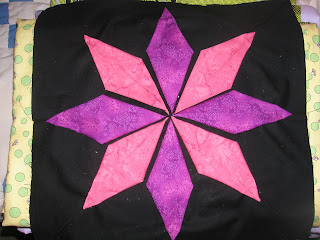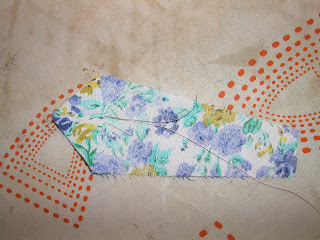So, I've finished the top which Tina had donated to project Linus. She can't remember what the pattern was, and looking at it, no offence Tina, but I think you've made a mistake somewhere when you sewed the blocks together! No problems though, it makes an excellent Linus quilt.
 Then I finally made up November's block for our challenge group, Flutterwheels. Last year's theme was stars, and the last block was Jennie Rayment's 'Star Flower'. Jennie is famous for her fabric manipulation, and very clear instructions, although that didn't make me less apprehensive about tackling this block.
Then I finally made up November's block for our challenge group, Flutterwheels. Last year's theme was stars, and the last block was Jennie Rayment's 'Star Flower'. Jennie is famous for her fabric manipulation, and very clear instructions, although that didn't make me less apprehensive about tackling this block.  The brief was to use analogous clours (colours next to each other on the colour wheel) and I chose red (in this case, pink) and red/purple. I still need to sew the ends of the petals down, but it's looking OK so far.
The brief was to use analogous clours (colours next to each other on the colour wheel) and I chose red (in this case, pink) and red/purple. I still need to sew the ends of the petals down, but it's looking OK so far.
Then I had a bit of a rumage through my UFO box and found some Dresden plate kits I had made up for a demonstration table I did ages ago. The pieces were all cut out, so it seemed a shame not to make them up, while I was up for chain piecing.

This one lacks its centre, but is complete. These pointed rays are really easy to do.
First you cut your rays out. 

Then you sew along the top by machine. (This is where the chain-piecing comes in.) Clip the folded edge of the ray.
 Turn the ray right sides out, poking the point out well with a pencil or something which is not a scissor point or you'll make a hole, like I did!
Turn the ray right sides out, poking the point out well with a pencil or something which is not a scissor point or you'll make a hole, like I did! Now press! Join them together matching the sides of the rays, until you have made a circle. It depends on the size of the ray as to how many you need. (Mine were quite small and needed 24 rays for a circle.) Lay the plate onto a square of backing fabric and applique down by hand or machine. Applique a circle in the middle to hide all the mess in the centre. Easy! Now I just need to join up 72 more and I'm in business!
Now press! Join them together matching the sides of the rays, until you have made a circle. It depends on the size of the ray as to how many you need. (Mine were quite small and needed 24 rays for a circle.) Lay the plate onto a square of backing fabric and applique down by hand or machine. Applique a circle in the middle to hide all the mess in the centre. Easy! Now I just need to join up 72 more and I'm in business!
5 comments:
I love Dresden plate. I think it's the mixture of machine and hand work.
I had to go get my book out to be sure, but I found it. The quilt your friend donated is a pattern called Mystery Sampler from the book Fat Quarter Quilts by M'Liss Rae Hawley. I knew it was.... the minute I saw it in the book, I remember thinking hm.... unusual quilt. I knew I'd never make it! LOL So, Mystery Solved!!! Your friend probably DID follow the pattern!!!
wow...you sure made that dresden plate look easy :) thanks for the tips!
Paula beat me to it about the name of the quilt...I have the book if you ever want to have a look at it.
Your star block looks great...I'm still not brave enough to show mine on-line :o)
I think Tina's quilt is great. It has a 'freedom' to the arrangement of blocks without looking wrong. Great quilt :)
Post a Comment